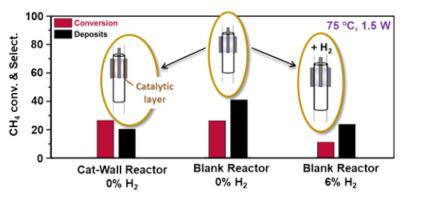Journal of Energy Chemistry ( IF 14.0 ) Pub Date : 2020-09-11 , DOI: 10.1016/j.jechem.2020.09.006 Nuria García-Moncada , Toine Cents , Gerard van Rooij , Leon Lefferts

|
The effect of temperature and hydrogen addition on undesired carbonaceous deposit formation during methane coupling was studied in DBD-plasma catalytic-wall reactors with Pd/Al2O3, using electrical power to drive the reaction. Experiments with thin catalyst layers allowed comparison of the performance of empty reactors and catalytic wall reactors without significantly influencing the plasma properties. The product distribution varies strongly in the temperature window between 25 and 200 °C. Minimal formation of deposits is found at an optimal temperature around 75 °C in the catalytic-wall reactors. The selectivity to deposits was c.a. 10% with only 9 mg of catalyst loading instead of 45% in the blank reactor, while decreasing methane conversion only mildly. Co-feeding H2 to an empty reactor causes a similar decrease in selectivity to deposits, but in this case methane conversion also decreased significantly. Suppression of deposits formation in the catalytic-wall reactor at 75 °C is due to catalytic hydrogenation of mainly acetylene to ethylene. In the empty reactor, H2 co-feed decreases conversion but does not change the product distribution. The catalytic-wall reactors can be regenerated with H2-plasma at room temperature, which produces more added-value hydrocarbons.
中文翻译:

使用结构化加氢催化剂将等离子体诱导甲烷中的碳沉积降至最低
在具有Pd / Al 2 O 3的DBD-等离子催化壁反应器中,利用电能驱动反应,研究了温度和氢的添加对甲烷偶联过程中不希望的碳沉积物形成的影响。薄催化剂层的实验可以比较空反应器和催化壁反应器的性能,而不会显着影响等离子体性能。产品分布在25到200°C的温度范围内变化很大。在催化壁反应器中,在约75°C的最佳温度下,发现形成的沉积物最少。沉积物的选择性约为10%,催化剂负载量仅为9 mg,而不是空白反应器中的45%,而甲烷转化率仅适度降低。共同进料H 2进入空反应器会导致类似的沉积物选择性下降,但在这种情况下,甲烷转化率也显着下降。在75°C的温度下,催化壁反应器内沉积物形成的抑制是由于主要是乙炔催化加氢为乙烯。在空反应器中,H 2共进料降低转化率,但不改变产物分布。催化壁反应器可以在室温下用H 2-等离子体再生,从而产生更多的增值烃。











































 京公网安备 11010802027423号
京公网安备 11010802027423号